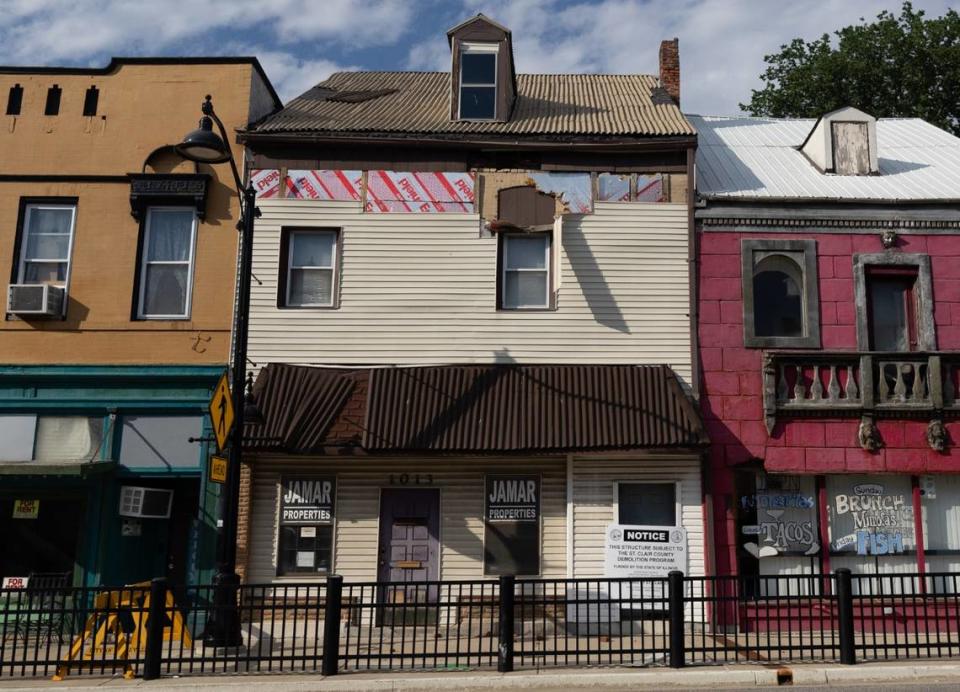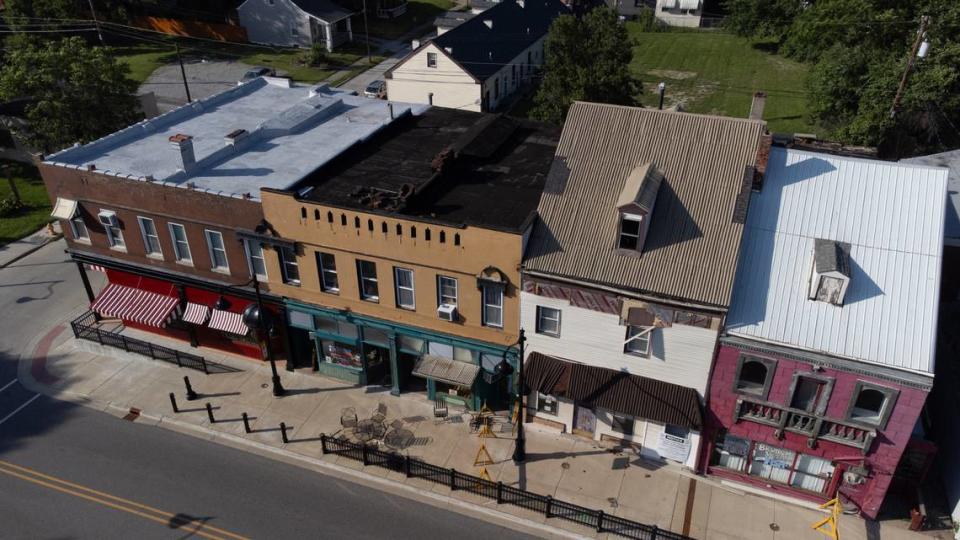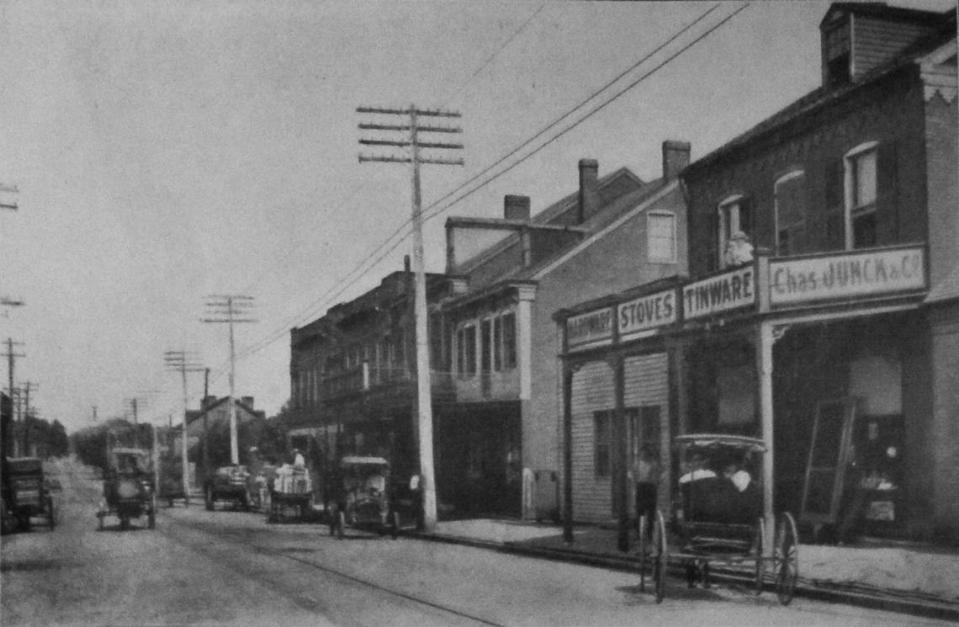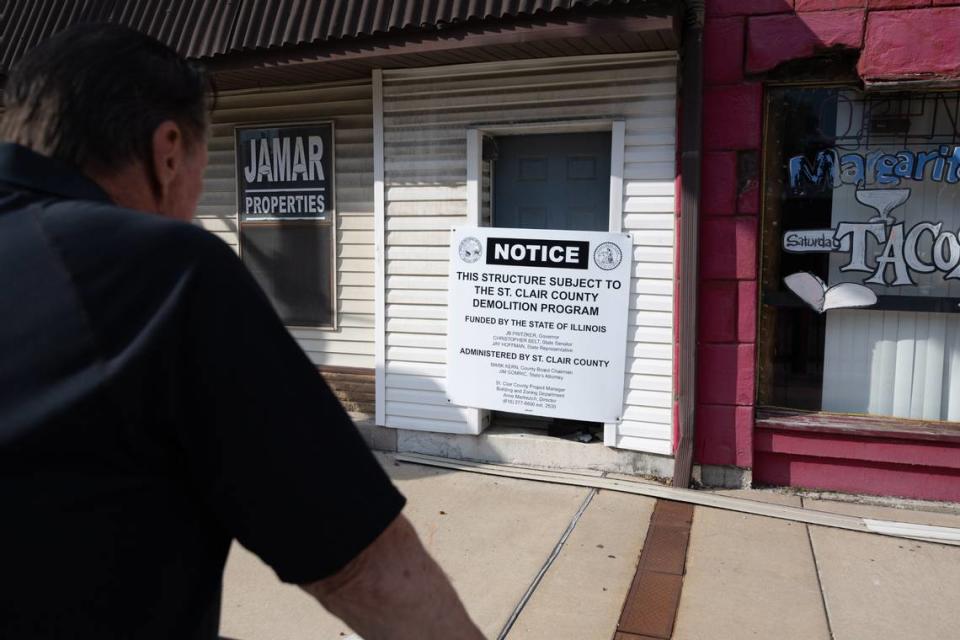Belleville Historical Society implores county and city not to demolish 1860s storefront
Belleville Historical Society is asking St. Clair County and the city of Belleville to halt a plan to demolish a vacant storefront on West Main Street that was built during the Civil War.
The county acquired it last fall after 10 years of unpaid property taxes that ended up part of bankruptcies filed by former owners. City officials had complained about the building’s derelict condition. It’s supposed to come down within 90 days of a May 1 contract.
Society President Larry Betz implored aldermen at a City Council meeting Monday night to pause the demolition and give experts a chance to assess what could be done to save the storefront at 1013 W. Main St.
“There’s a list of a whole bunch of people (on a sign out front) that think they’re really doing a grand thing for Belleville by tearing this building down, and I would say they’re not,” he said.
Betz suggested that the $35,800 earmarked for demolition be used for restoration instead.
The 2 1/2-story brick storefront is in Town of West Belleville Historic District, which is listed on the National Register of Historic Places but has no restrictions beyond regular housing codes. Local residents have been working to preserve and promote its history, which began in 1852.
Bob Brunkow, the Society’s historian, said the storefront is on one of the city’s few remaining fully-intact blocks of historical buildings, although some are hidden by siding or facades.
Betz likened demolition of a storefront in a row of storefronts to someone pulling a tooth, leaving a gaping hole, and he argued that vacant lots between buildings give neighborhoods a blighted look.
“The fact that they didn’t consider other options, that’s the thing that bothers me,” Brunkow said. “Demolition has become the go-to.”
The city of Belleville has spent hundreds of thousands of dollars to tear down more than 100 derelict homes and other buildings in the past 12 years. Some people worry that it’s destroying the city’s rich architectural history. Others applaud the elimination of eyesores.
The West Main Street storefront is “unstable” and “falling apart,” according to Mayor Patty Gregory.
“It’s a safety issue,” she said.

County got state grant
St. Clair County announced earlier this month that it would use a $2 million state grant to demolish “unsafe and blighted” buildings it had acquired through foreclosure from owners who neglected to pay property taxes.
The first round includes the storefront at 1013 W. Main St. and 30 homes in Cahokia Heights, which Director of Building and Zoning Anne Markezich called the “worst of the worst.” She’s overseeing the demolition project.
The total cost for the first round is $260,780. The most expensive demolition involves the storefront at $35,800.
“It’s a danger right now. The brick is falling off,” Markozich said, referring to an area at the top of the building, where tan vinyl siding has peeled away, exposing loose brick that now is secured by foam board.
Markozich said she got the list of buildings to be demolished from the state’s attorney’s office, which handled the grant application, and she wasn’t sure what was wrong with the West Main Street storefront beyond the loose brick.
Markozich referred questions to Dan Lewis, first assistant state’s attorney, who didn’t return phone calls on Wednesday.
Scott Tyler, the city of Belleville’s director of health, housing and building, said the city had considered demolishing the storefront, which had been vacant and derelict for years.
“But we stopped everything, other than barricading the sidewalks off (to protect pedestrians), after we found out it was in the possession of St. Clair County,” he said. “And we called them, and they said, ‘Yeah, we’ll take care of it,’ so we didn’t send any engineers out there to look at it.”
Tyler said he later saw what looked like inspectors at the site and assumed the county had sent them, but he didn’t know what they concluded about the storefront’s stability.
Betz told the City Council he doubts the building can be torn down without endangering the structural integrity of abutting storefronts on either side. According to county records, both are owned by Ronnie Phillips, who operates the Spaces venue downtown. He couldn’t be reached for comment.
Betz said he hasn’t been inside the storefront at 1013 W. Main St., but it looks stable on the outside.
“The roof seems to be in good shape, front and back, and that’s the most important part,” he said. “... You don’t tear a building down just because there are a couple of bricks falling off of it. That can be fixed.”

20 people tried to buy it
St. Clair County Board entered into a contract for the 31 demolitions on May 1 with Hayes Contracting. County Board Chairman Mark Kern said the work would begin immediately.
The contract gives Hayes 90 days to complete the project.
“There will be more (demolitions) until the money runs out,” Kern said earlier this month.
The storefront at 1013 W. Main St. was most recently owned by Will and Julia Weeks. Will Weeks operated Jamar Properties, a real-estate and management company. He died in 2019.
The Weekses stopped paying property taxes about 10 years ago, and bills got tied up in bankruptcy court, according to Whitney Strohmeyer, president of Joseph E. Meyer & Associates, the Edwardsville-based company that serves as the county’s trustee and delinquent-tax agent.
By the time the county foreclosed and obtained a deed in November, the property had accumulated about $40,000 in back taxes and penalties.
“We had it in the January auction, and we got 20 bids on it, but it was pulled out of the auction before it ended because the city was going to demolish it,” Strohmeyer said, noting that Belleville City Clerk Jenny Meyer notified the trustee in a February email.
Bids had ranged from about $3,000 to $12,500.
Tyler said he isn’t sure a purchase would have solved the problem since many anonymous limited-liability companies buy derelict properties at tax auctions for cheap, then continue allowing them to deteriorate.
Eric Schauster, the city’s assistant director of economic development, planning and zoning, questioned the historical significance of the storefront at 1013 W. Main St. compared to other buildings in Town of West Belleville Historic District.
Schauster pointed to a survey conducted before the district was placed on the National Register of Historic Places in 2014.
“That property was listed as being a ‘non-contributing’ property,” he said. “According to the survey, it did not contribute to the historic value of the district at that time, likely because it was covered with siding.”
Brunkow said the “non-contributing” categorization doesn’t lessen the storefront’s importance because such buildings can become “contributing” if siding or facades are removed to reveal original structures.

Town established in 1852
The town of West Belleville was established in 1852. Some of its streets, such as Silver, Gold and Iron, were later renamed.
The town’s public square was at the intersection of what is now West Main Street and 11th Street. It had a wagon-size scale, where businesses could weigh commodities, mainly coal and hay, that were being sold.
Town leaders decided to merge with Belleville in 1882.
Brunkow believes Jacob and Rosalie Schlupp, German immigrants from France, built the storefront at what is now 1013 W. Main St. between 1860 and 1866, when they sold it to Philip Weber for $4,000. For the first two decades, it housed a saloon. Then Philip Schmidt rented it.
“He was not only a dealer but a maker of shoes,” Brunkow said.
The storefront later housed a millinery, meat market, dry-goods store and bakery before the Weekses bought it in the 1980s.
Belleville Historical Society stopped demolition of another building on the southwest corner of West Main Street and 11th Street in 2011. The German-American folk house was built around 1875. Volunteers are gradually restoring it as a visitor center for the historic district.
The city recently erected signs explaining the history of West Belleville, but officials haven’t followed through on a plan to install brick sidewalks, according to Betz.
“We’ve taken steps to save a very significant house in West Belleville, and there are other people who are trying to highlight the historic value of the area, but that’s getting harder to do when they’re taking down buildings,” he said.
“It’s time for the city to step up and do their part, if they deem that the architectural history of Belleville is important.”
Gregory and Schauster said officials have worked with developers to preserve several historic buildings through the city’s Infill Redevelopment Program, and they expect that to grow in the future.
A developer went through the program in March to buy a derelict 1884 “mansion” on East D Street for $1 with plans to renovate it. That home was slated for demolition before news coverage garnered interest.
“We’re ramping (the Infill program) up,” Schauster said.


